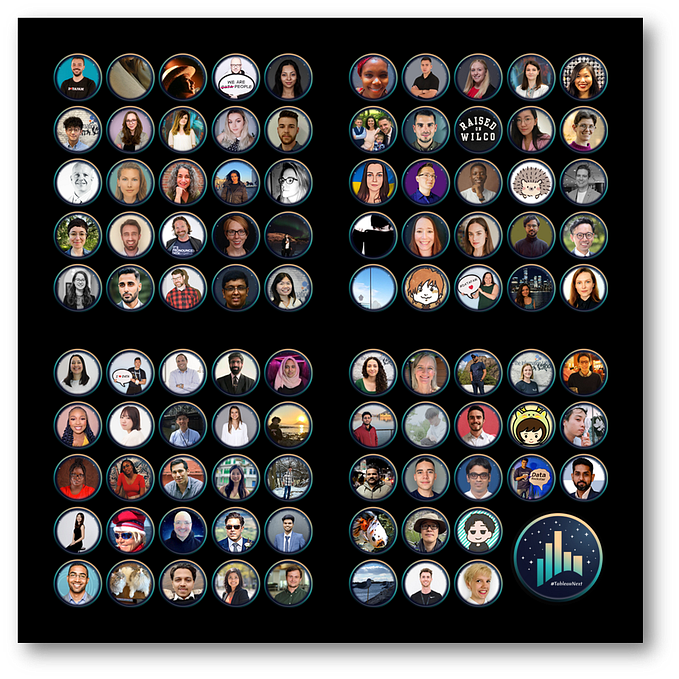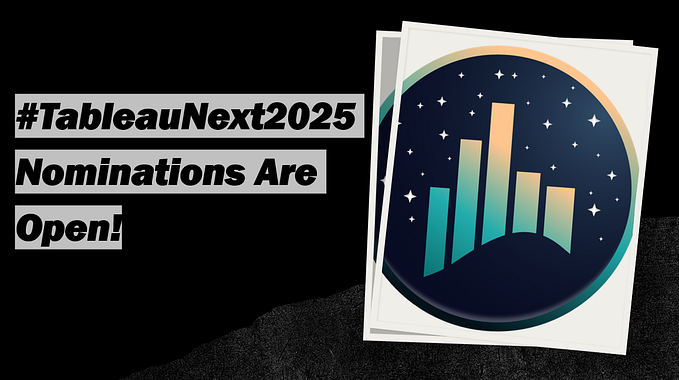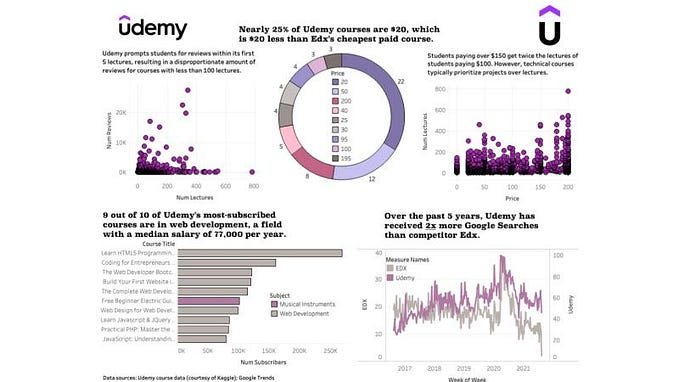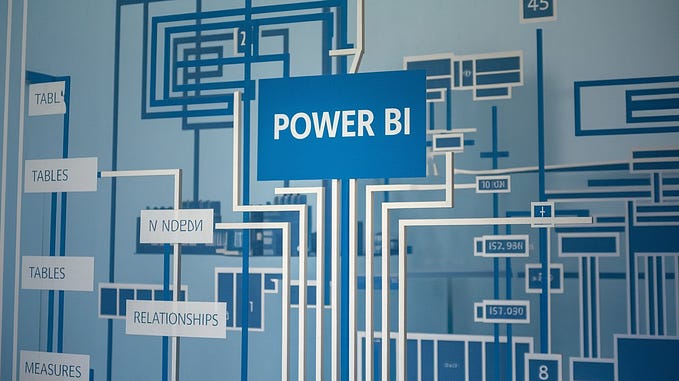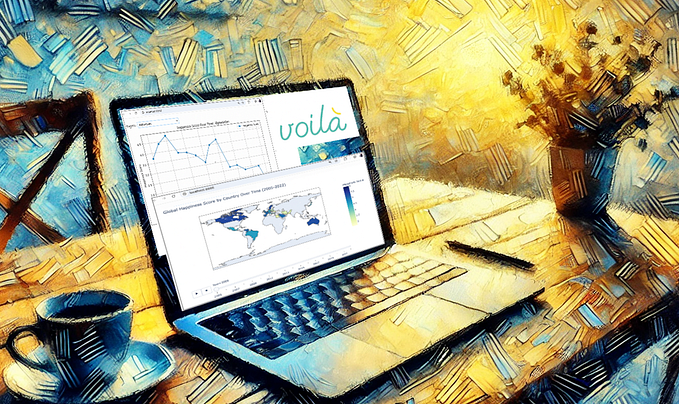Data Viz Thoughts .|: Ivett Kovács Interview & Kasia Gasiewska-Holc has our #VOTW
A Tableau-centric weekly blog about the viz making process, #datafam member interviews, #DataVizThoughts Viz of the Week + entertainment for introverts (consisting of a music morsel & a binge bite).

This week we feature an interview with Ivett Kovács (@IvettAlexa) and Kasia Gasiewska-Holc(@bluedilphia) has our (gore-tastic) Viz of the Week!

Ivett (@IvettAlexa) was one of the 1st #datafam members to encourage me & give me hope that this was the community for me — even before I joined Twitter — I ‘met’ her in the Tableau Magicians FaceBook Group and she was super friendly there. (1) Beyond that, she’s effortlessly cool + her vizzes are otherworldly!
Adam Mico (AM): When you reached a huge & very much earned milestone of 1,000 followers, you mentioned you were from a small European country. What impact has the milestone had and how did your youth prepare you to become a data visualization artist?
Ivett Kovács (IK): I would have never thought that so many people would love my visualizations. It’s an incredible feeling and the best part is getting feedback from the professionals of the community. Choosing this career path was not a conscious choice… at all. I have always loved art — wherever I go in the world, the first thing I do is visit the museums and galleries. I took drawing lessons at school and wanted to go in that direction, but it didn’t pan out, so I started studying economics. Somehow these coalesced and now I’m lucky enough to mix art and math in my daily work.
AM: I see that you are a graduate of the Budapest School of Finance and Accountancy and have worked at Starschema LTD since you graduated. When attending school, did you envision become a dashboard developer and designer, or did it ‘just happen’?
IK: Everything just happened. I followed the flow. I didn’t know a thing about the data viz profession when I started. Eight years ago in Hungary, there wasn’t even a Data Visualization/Designer role. I used to create line and bar charts in Excel during my statistics courses at university and that’s all. I have learned through self-development — I read studies and read dataviz-related books.
I didn’t know anything about the background of the profession, what principles and rules I should follow. I’ve become obsessed with the psychology and cognitive background as well. It’s amazing & also a lil’ bit sad how people can be deceived by visual communication.
AM: How has your job evolved since you began working for them?
IK: Sometimes it’s scary to say that I have been working here for almost 8 years. I started as a business analyst, but two months later, I began my first project using Tableau — that was the first Tableau project in Hungary and I worked on it together with my boss Tamás Földi (his Twitter). None of us had any experience with the tool at that time. Today he is one of the best-known Tableau Zen Masters and I am a Tableau Public Ambassador. As I mentioned, back then I wasn’t fully aware of the ‘ins and outs’ of data visualization. It was a challenge to learn the tool or even the BI world itself.
I continue to have plans on improving my skills. I got a lot of inspiration from the Encode Conference in London where I had the chance to participate a few weeks ago.
AM: Your vizzes incorporate a lot of drawing using math with an adroit eye for design.
a. Do you have a history in other types of art prior to creating Tableau ‘math art’ or has this begun when you could use math to draw shapes?
b. Have you always loved math and what is your 1st memory of falling in love with math?
IK: I love Giorgia Lupis’, Federica Fragapone’s, Valentina D’Efilippo’s and many other designers’ works. Their visual creations are very inspiring and unique. When making custom visualizations in Tableau, thinking outside the box is inevitable but strong math skills are also required. Of course, it happens to me that the solutions I come up with sometimes turn out to be impossible to do and I have to come up with a different solution. I owe a lot to one or two colleagues of mine who are always eager to help me if I get stuck on a crazy idea.
I haven’t always liked math. Even though I understood the theory, it’s completely different when you get to use mathematical functions in real life. Using mathematical functions to draw graphs can be a big challenge, but it’s well worth the effort; I usually love those graphs the most.
AM: You publish consistently, but not super-frequently — when you do, they appear to be very inspired. Is there one thing that generates that creative burst or is it kind of random?
IK: Randomly, I’ll see a poster or a painting in a museum, a leaf in a forest or a beautiful caracole form and suddenly an idea comes to mind. In general, the first thing that comes to mind is a design idea and I’m waiting for the right dataset through which I can bring it to life. Of course, in the office, business reports follow the opposite flow because the data is given and the process is generally framed [with requirements].
AM: Your process is of great interest because of your hybrid approach of data and artistry. When you dig into a viz, do you already see what you want to create or does it evolve as you develop?
For example, Sorry Sweetie kind of came from nowhere as I haven’t seen anything like it with a gradient sphere and would love for you to share that process.
IK: Yes. When I start working, I have a really detailed image in my head and I try to bring it to life.
For example:
When I was in DC, I had the opportunity to visit museums. :) (2) One day, I went to the Hirshhorn Museum where I saw the Guerrilla Girls’ exhibition about gender inequality in the art world. I was completely shocked by the numbers; I just felt like I want to show that data more visually than in a table view (as it was exhibited there). In previous weeks, there was the Tableau Conference in Berlin where Ludovic Tavernier (@ltavernier7) presented the implementation of Gradient Area chart. It was very inspiring to me and I blended a gradient design into my Sorry Sweetie work.
I’m glad you are interested in the process. I will share that at TC19 in Vegas; Tableau Zen Master Klaus Shulte (@ProfDrKSchulte) and I have a presentation called Surprise Me on Thursday afternoon before the Data Night Out. :D (3) We will share some of our most valuable techniques we have applied to create our custom visualizations. (4)
In the meantime, I recommend this post. It is about the Gradient Colors and Ludovic was my co-writer at this blog post who described in detail how you can make gradient circle/ball in Tableau.
AM: Have there been any vizzes you worked on a lot, only not to complete? Please explain what happened and whether you plan to pursue it in the future.
IK: In my head there are so many vizzes yet to be made. But yeah… of course there are several that I started & never finished. Either I did not have time to delve into it or I was not very attached to the subject. This may sound strange but it is important for me to really be interested in the topic I am doing visualization for; I hope I can devote more time to make more public visualizations in the future.
I have just started my own project; I ask a question which you probably would not answer in front of others. I print it as a poster and put it into a private place (e.g. a lift or a restroom).
For example, I’ve asked about how the happiness and wealth connect to each other? I have many many questions and ready posters on my laptop so maybe you will meet one like that. If you have any ideas for questions I would welcome them.
AM: Gender inequality in tech has been a hot topic for years. What advice do you have to women that want to pursue tech development/coding/data visualization as a career (rather than policy advisers or ‘non-tech’ business analysts)?
IK: For a very long time, women haven’t been encouraged to pursue careers in the tech industry or Even non-tech like art or politics (in many places). Men hold these positions all over the world, and it feels more appealing to choose working environments where we women can identify with our peers, leading to some disparity — this inequality can also be observed among ethnic groups.
I think companies, or other organizations like museums (if we’re talking about the arts), have a responsibility to give women the same opportunities as their male employees.
For women in the dataviz profession my advice is:
• Reach out and find mentors and friends who share your passions. Believe that you are not alone.
• Lots of events already exist. Go to these events and be part of the community. (5)
- If you are already working in this profession, please be visible. If inspirational women share their own journeys and passions, then more young girls will dare to follow in their footsteps. We need you!
AM: I like to end with a silly question. Is there one fun ‘talent’ or quirk you have that surprises people. Please share what that is…
IK: I love eating bugs!
Viz of the Week

Kasia (@bluedilphia) has a relatively short Tableau Public viz portfolio (11 in a year and a half); even with that compact sample, the technical execution and public success of her vizzes puts her comfortably in the top tier of Tableau Public creators. I adored this viz for the reasons you will see referenced below and chat with her about it and her process.
Adam Mico (AM): Everything is so smoothly animated on ‘Spookyman’ on a variety of levels. What was your animation process and how long did it take to coordinate?
Kasia Gasiewska-Holc (KGH): For animations, I went with the method that I’ve already used a couple of times in my other Tableau projects. Basically, I’ve created a vector SVG graphic and converted it to .html — this is what allowed for the animations to be executed in the web environment. The process was quite lengthy but only because of me and my crazy ideas about it. Initially, I was only planning on making the pumpkins dangle a little but once I accomplished that I felt it wasn’t enough, so I kept adding different elements to it. Some of them, like leaves on trees, were a bit trickier to animate as there were two different types of animations to be performed on them — moving from one point to another and rotating, all at the same time. But I got there in the end!
AM: What were some of the challenges of this viz? I’m sure you had to use a lot of calculations and parameters to create the game, but what other struggles did you encounter?
KGH: There were two main challenges I stumbled upon when creating this viz. First, I had a bit of a struggle to randomize mystery words every time someone plays the game. I tried different options but ended up with a combo of a RANDOM() function and a parameter action. Thanks to the latter, I was able to control randomization so that a number changes only upon selecting a difficulty level. Then, it’s passed to the parameter and will only change once the game is restarted and the difficulty level is selected again.
Another challenge was to design the best method of selecting letters. First, I went with a simple, type-in parameter but the problem with this was that every single time a letter has been typed in, a user would have to hit enter to check if there’s a match. Additionally, if someone would try to type in next letter, it was very easy to remove all previously guessed letters. I’ve asked some friends to have a look at my viz before I published it and they were the ones who pointed out that this was a bit of an issue, so I knew I had to find a better way of doing that. I ended up with another set of parameter actions, this time passing information on individual letters selection. I think after this project parameter actions might be my new fave Tableau feature, ha! (6)
AM: Halloween comes but once a year. How long has it been since this viz was thought of and was it hard to wait until October to publish?
KGH: I think I started working on this viz at the beginning of October. Actually, the original theme of the viz was not Halloween — I wanted to create a hangman game where mystery words would be referring to the Tableau community (Tableau vocabulary, names of people contributing to the community & etc.)! In the end my love towards all-things-Halloween won. But who knows, maybe one day I’ll also create what I originally had in mind!
AM: Are you monitoring success rates and how have people been doing? (7)
KGH: I’m not monitoring how people are doing but I sincerely hope that, even if losing, they still have fun with it!
Music Morsel
Aldous Harding is a spellbinding New Zealand indie-folk artist. Zoo Eyes was released less than two weeks ago & gives me such a sense of immediacy and wonderment that even a peculiar Teletubbies-adjacent video cannot peel me from this hauntingly dynamic tune. Check out her YouTube Mix —the entire collection is stunning.
Binge Bite
Insatiable (Season 2) is about most stuff I generally don’t give a crap about (pageants, teens, relationships, beauty and etc.), but the it’s a lively dark-humored romp that just landed in Netflix. The show received a lot of negative heat last year for its unfair ‘fat-shaming’ categorization (8), so the impact of that ire has been felt a little in Season 2… but this semi-guilty pleasure is still mostly a joy & a goof.
Footnotes
1) This was in my absolute beginning and nobody knew who I was… I’m sure she has second and third thoughts now… hehe
2) My favorite part about Washington D.C. are the magnificent free museums. Here is a list of 15 great free museums in D.C.
3)It’s definitely better than a morning slot following ‘Data Night Out’ & I’m so disappointed I will not be able to make TC19. I fully expect to be there next year. :/
4) And if I needed more reason to be bummed about missing TC19… at least we get a nice little preview in our nook.
5) If you do not live in a big city or have access to ‘in person’ events in your area, there are many on-line opportunities to join a community — one great place is the Twitter #datafam community.
6) Parameter actions are awesome!
7) I played once and got wretched, but missed two early using an ’N’ and a ‘S’.
8) Critics shaming the show — if the people that criticized it watched and understood it, they would have realized this was framed as a cautionary tale & the good bit last a hot minute and it unraveled quickly.



